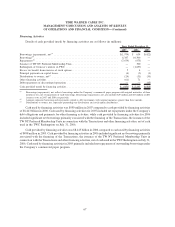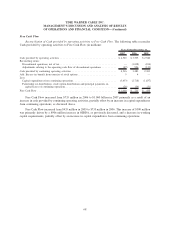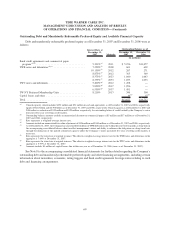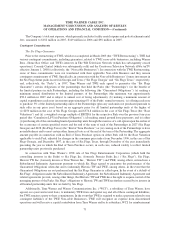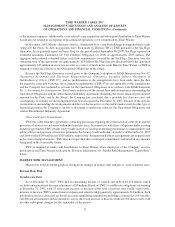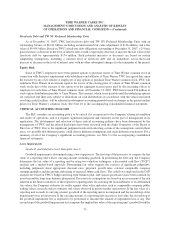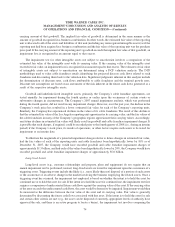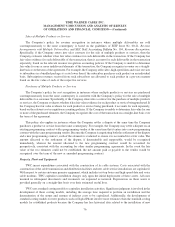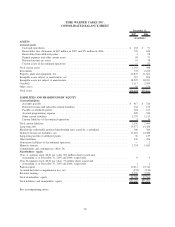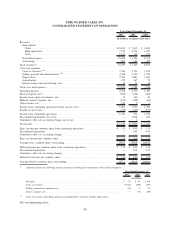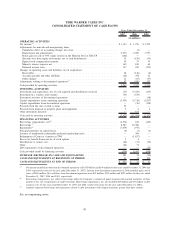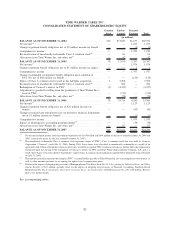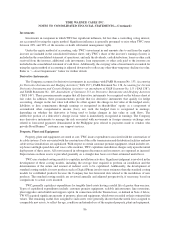Time Warner Cable 2007 Annual Report Download - page 81
Download and view the complete annual report
Please find page 81 of the 2007 Time Warner Cable annual report below. You can navigate through the pages in the report by either clicking on the pages listed below, or by using the keyword search tool below to find specific information within the annual report.Sales of Multiple Products or Services
The Company’s policy for revenue recognition in instances where multiple deliverables are sold
contemporaneously to the same counterparty is based on the guidelines of EITF Issue No. 00-21, Revenue
Arrangements with Multiple Deliverables, and SEC Staff Accounting Bulletin No. 104, Revenue Recognition.
Specifically, if the Company enters into sales contracts for the sale of multiple products or services, then the
Company evaluates whether it has fair value evidence for each deliverable in the transaction. If the Company has
fair value evidence for each deliverable of the transaction, then it accounts for each deliverable in the transaction
separately, based on the relevant revenue recognition accounting policies. If the Company is unable to determine
fair value for one or more undelivered elements of the transaction, the Company recognizes revenue on a straight-
line basis over the term of the agreement. For example, the Company sells video, high-speed data and voice services
to subscribers in a bundled package at a rate lower than if the subscriber purchases each product on an individual
basis. Subscription revenues received from such subscribers are allocated to each product in a pro-rata manner
based on the fair value of each of the respective services.
Purchases of Multiple Products or Services
The Company’s policy for cost recognition in instances where multiple products or services are purchased
contemporaneously from the same counterparty is consistent with the Company’s policy for the sale of multiple
deliverables to a customer. Specifically, if the Company enters into a contract for the purchase of multiple products
or services, the Company evaluates whether it has fair value evidence for each product or service being purchased. If
the Company has fair value evidence for each product or service being purchased, it accounts for each separately,
based on the relevant cost recognition accounting policies. If the Company is unable to determine fair value for one
or more of the purchased elements, the Company recognizes the cost of the transaction on a straight-line basis over
the term of the agreement.
This policy also applies in instances where the Company settles a dispute at the same time the Company
purchases a product or service from that same counterparty. For example, the Company may settle a dispute on an
existing programming contract with a programming vendor at the same time that it enters into a new programming
contract with the same programming vendor. Because the Company is negotiating both the settlement of the dispute
and a new programming contract, each of the elements is evaluated to ensure it is accounted for at fair value. The
amount allocated to the settlement of the dispute, if determinable and supportable, would be recognized
immediately, whereas the amount allocated to the new programming contract would be accounted for
prospectively, consistent with the accounting for other similar programming agreements. In the event the fair
value of the two elements could not be established, the net amount paid or payable to the vendor would be
recognized over the term of the new or amended programming contract.
Property, Plant and Equipment
TWC incurs expenditures associated with the construction of its cable systems. Costs associated with the
construction of the cable transmission and distribution facilities and new cable service installations are capitalized.
With respect to certain customer premise equipment, which includes set-top boxes and high-speed data and voice
cable modems, TWC capitalizes installation charges only upon the initial deployment of these assets. All costs
incurred in subsequent disconnects and reconnects are expensed as incurred. Depreciation on these assets is
provided generally on a straight-line basis over their estimated useful lives.
TWC uses standard costing models to capitalize installation activities. Significant judgment is involved in the
development of these costing models, including the average time required to perform an installation and the
determination of the nature and amount of indirect costs to be capitalized. Additionally, the development of
standard costing models for new products such as Digital Phone involve more estimates than the standard costing
models for established products because the Company has less historical data related to the installation of new
76
TIME WARNER CABLE INC.
MANAGEMENT’S DISCUSSION AND ANALYSIS OF RESULTS
OF OPERATIONS AND FINANCIAL CONDITION—(Continued)



